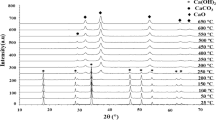Abstract
Metal oxides in general have surface acidic sites, but for exceptional circumstances, are not expected to mineralize CO2. Given their intrinsic basicity and an expandable interlayer gallery, the hydrotalcite-like layered double hydroxides (LDHs) are expected to be superior candidate materials for CO2 mineralization. However, the incorporation of Al3+ adversely impacts the ability of the metal hydroxide layer to interact with CO2 in the gas phase in comparison with the unitary Mg(OH)2. Thermogravimetric analysis shows that the decomposition reaction of the [Mg–Al–CO3] LDH is only marginally delayed in flowing CO2 in comparison with flowing N2, showing only an apparent marginal CO2 uptake. Al3+ ion severely attenuates the surface basicity of the LDHs, as the unitary Al(OH)3 is acidic in comparison with Mg(OH)2 and shows little or no interaction with CO2 in the gas phase.







Similar content being viewed by others
References
Wang Q, Luo J, Zhong Z and Borgna A 2011 Energy Environ. Sci. 4 42
Wang J, Huang L, Yang R, Zhang Z, Wu J, Gao Y, Wang Q, O’Hare D and Zhong Z 2014 Energy Environ. Sci. 7 3478
Ram Reddy M K, Xu Z P, Lu G Q and Diniz Da Costa J C 2008 Ind. Eng. Chem. Res. 47 7357
Jänchen J, Möhlmann D T F and Stach H 2007 Stud. Surf. Sci. Catal. 170 2116
Yong Z, Mata V and Rodrigues A 2002 Sep. Purif. Technol. 26 195
Williams G R and O’Hare D 2006 J. Mater. Chem. 16 3065
Meyn M, Beneke K and Lagaly G 1990 Inorg. Chem. 29 5201
Radha A V, Thomas G S, Kamath P V, Antonyraj C A and Kannan S 2010 Bull. Mater. Sci. 33 319
Bellotto M, Rebours B, Clause O, Lynch J, Bazin D and Elkaim E 1996 J. Phys. Chem. 100 8535
Valcheva-Traykova M L, Davidova N P and Weiss A H 1993 J. Mater. Sci. 28 2157
Uzunova E L, Mitov I G and Klissurski D G 1997 Bull. Chem. Soc. Jpn. 70 1985
Sato T, Kato K, Endo T and Shimada M 1986 React. Solids 2 253
Rajamathi M, Nataraja G D, Ananthamurthy S and Kamath P V 2000 J. Mater. Chem. 10 2754
Miyata S 1980 Clays Clay Miner. 28 50
Yong Z and Rodrigues A E 2002 Energy Convers. Manag. 43 1865
Ficicilar B and Dogu T 2006 Catal. Today 115 274
Gao Y, Zhang Z, Wu J, Yi X, Zheng A, Umar A, O’Hare D and Wang Q 2013 J. Mater. Chem. A 1 12782
Ram Reddy M K, Xu Z P, Lu G Q M and Costa J C D 2008 Ind. Eng. Chem. Res. 47 2630
Radha S and Navrotsky A 2014 J. Phys. Chem. C 118 29836
Zhao X, Zhang F, Xu S, Evans D G and Duan X 2010 Chem. Mater. 22 3933
Reichle W 1986 Solid State Ion. 22 135
Olanrewaju J, Newalkar B L, Mancino C and Komarneni S 2000 Mater. Lett. 45 307
Marappa S, Radha S and Kamath P V 2013 Eur. J. Inorg. Chem. 2013 2122
Kloprogge J T, Kristof J and Frost R L 2003 2001—A Clay Odyssey 451
Ram Reddy M K, Xu Z P, Lu G Q M and Costa J C D 2006 Ind. Eng. Chem. Res. 45 7504
Wang Q, Gao Y, Luo J, Zhong Z, Borgna A, Guo Z and O’Hare D 2013 RSC Adv. 3 3414
Chang P H, Chang Y P, Chen S Y, Yu C T and Chyou Y P 2011 Chem. Sus. Chem. 4 1844
Beruto D T, Botter R, Lagazzo A and Finocchio E 2012 J. Eur. Ceram. Soc. 32 307
Wang Q, Tay H H, Zhong Z, Luo J and Borgna A 2012 Energy Environ. Sci. 5 7526
Acknowledgements
We thank the Department of Science and Technology (DST), Government of India (GOI), for financial support. PVK is a recipient of the Ramanna Fellowship of the DST. We also thank the reviewer for some useful comments.
ᅟ
Electronic Supplementary Material
Supplementary material pertaining to this article is available on the Bulletin of Materials Science website (www.ias.ac.in/matersci).
Author information
Authors and Affiliations
Corresponding author
Electronic supplementary material
Below is the link to the electronic supplementary material.
Rights and permissions
About this article
Cite this article
MARAPPA, S., KAMATH, P.V. Interaction of pristine hydrotalcite-like layered double hydroxides with CO2: a thermogravimetric study. Bull Mater Sci 38, 1783–1790 (2015). https://doi.org/10.1007/s12034-015-1042-5
Received:
Accepted:
Published:
Issue Date:
DOI: https://doi.org/10.1007/s12034-015-1042-5




